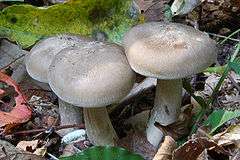Lyophyllum decastes
Lyophyllum decastes, commonly known as the fried chicken mushroom, is an edible species of fungus in the family Lyophyllaceae that grows in clusters on disturbed ground, with a faintly radish-like taste.[1]
| Lyophyllum decastes | |
|---|---|
 | |
| Lyophyllum decastes | |
| Scientific classification | |
| Kingdom: | |
| Division: | |
| Class: | |
| Order: | |
| Family: | |
| Genus: | |
| Species: | L. decastes |
| Binomial name | |
| Lyophyllum decastes | |
| Synonyms | |
| |
Appearance
Gills are white but may yellow slightly with age. The firm flesh remains white on exposure.[1]
L. decastes similar in appearance to the toxic species Lyophyllum loricatum, Lyophyllum connatum, Clitocybe dilatata, and those of the Entoloma genus.[2]
Ecology
Growing in dense, even huge clusters on the ground, L. decastes is usually found where the ground has been disturbed such as roadbeds, gravel, paths, landscaping areas, and sometimes in woods.[1]
Range
Prolific in summer and fall until spring on the U.S. West Coast, it is widely distributed in North America.[1]
Edibility
The species is edible when cooked. When consumed uncooked may cause liver failure, nausea, and diarrhea.[3]
References
- Phyla and decastes description
- Meuninck, Jim (2017). Foraging Mushrooms Oregon: Finding, Identifying, and Preparing Edible Wild Mushrooms. Falcon Guides. p. 98. ISBN 978-1-4930-2669-2.
- Phillips, Roger (2010). Mushrooms and Other Fungi of North America. Buffalo, NY: Firefly Books. p. 56. ISBN 978-1-55407-651-2.
Further reading
- Breitenbach, J. & Kränzlin, F. (1991). Fungi of Switzerland. Volume 3: Boletes and Agarics (1st Part). Strobilomycetaceae, Boletaceae, Paxillaceae, Gomphidiaceae, Hygrophoraceae, Tricholomataceae, Polyporaceae (lamellate). Verlag Mykologia: Luzern, Switzerland. p. 361.
- Moncalvo, J.-M. , Rehner, S. A. & Vilgalys, R. (1993). "Systematics of Lyophyllum Section Difformia Based on Evidence from Culture Studies and Ribosomal DNA Sequences". Mycologia 85(5): 788–794.